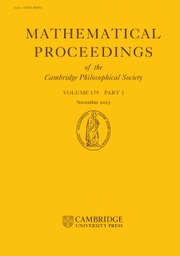No CrossRef data available.
Article contents
Maximal surfaces in the Lorentzian Heisenberg group
Published online by Cambridge University Press: 29 July 2025
Abstract
The 3-dimensional Heisenberg group can be equipped with three different types of left-invariant Lorentzian metric, according to whether the center of the Lie algebra is spacelike, timelike or null. Using the second of these types, we study spacelike surfaces of mean curvature zero. These surfaces with singularities are associated with harmonic maps into the 2-sphere. We show that the generic singularities are cuspidal edge, swallowtail and cuspidal cross-cap. We also give the loop group construction for these surfaces, and the criteria on the loop group potentials for the different generic singularities. Lastly, we solve the Cauchy problem for harmonic maps into the 2-sphere using loop groups, and use this to give a geometric characterisation of the singularities. We use these results to prove that a regular spacelike maximal disc with null boundary must have at least two cuspidal cross-cap singularities on the boundary.
Information
- Type
- Research Article
- Information
- Mathematical Proceedings of the Cambridge Philosophical Society , Volume 179 , Issue 3 , November 2025 , pp. 579 - 608
- Copyright
- © The Author(s), 2025. Published by Cambridge University Press on behalf of Cambridge Philosophical Society
Footnotes
Partially supported by Independent Research Fund Denmark, grant 9040-00196B.
Partially supported by Kakenhi 22K03265.

